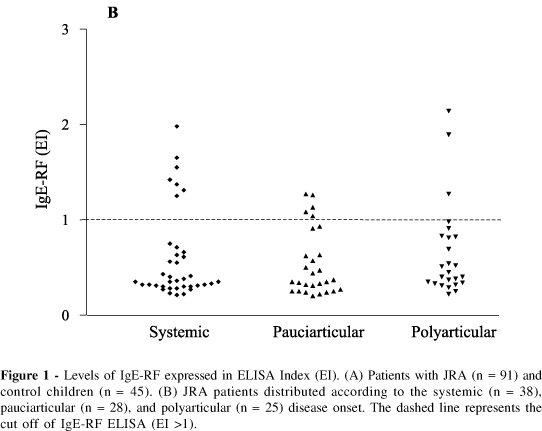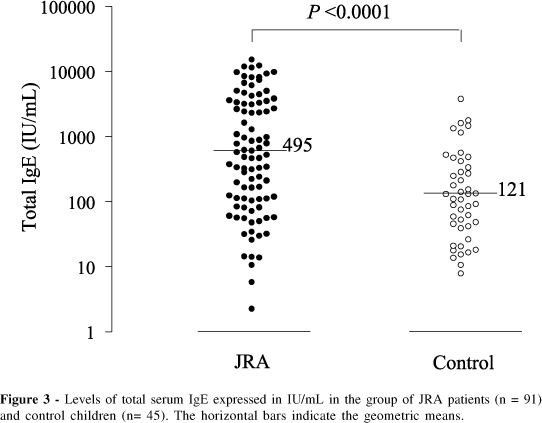OBJECTIVES: To determine the presence of immunoglobulin E-rheumatoid factor in patients with juvenile rheumatoid arthritis and to correlate it with clinical and laboratory parameters. METHODS: A multicenter prospective study was carried out from January 1993 to January 1999 with the enrollment of 3 centers of pediatric rheumatology. Ninety-one children with juvenile rheumatoid arthritis diagnosed according to the American College of Rheumatology criteria were studied: 38 (42%) with systemic, 28 (31%) with pauciarticular, and 25 (27%) with polyarticular onset. Ages ranged from 2.1 years to 22.6 years (mean 10.5 ± 4.7), with 59 (65%) girls. The control group consisted of 45 healthy children. The detection of immunoglobulin E-rheumatoid factor was carried out utilizing an enzyme-linked immunosorbent assay. Associations of immunoglobulin E-rheumatoid factor with immunoglobulin M-rheumatoid factor (latex agglutination test), total serum immunoglobulin E, erythrocyte sedimentation rate, antinuclear antibody, and functional and radiological classes III or IV were analyzed. RESULTS: Positive immunoglobulin E-rheumatoid factor was found in 15 (16.5%) of the 91 children with juvenile rheumatoid arthritis: 7 (18.5%) with systemic, 5 (18%) with pauciarticular, and 3 (12%) with polyarticular onset. A significant correlation was observed between immunoglobulin E-rheumatoid factor and total serum immunoglobulin E in the juvenile rheumatoid arthritis patients. No correlation was found between immunoglobulin E-rheumatoid factor and positive latex agglutination slide test, erythrocyte sedimentation rate, antinuclear antibody, or the functional and radiological classes III or IV in any disease onset group. In 4 out of 45 control children (8.9%), immunoglobulin E-rheumatoid factor was positive but with no correlation with total serum immunoglobulin E levels. CONCLUSIONS: Immunoglobulin E-rheumatoid factor could be detected in 16.5% of juvenile rheumatoid arthritis patients, particularly in those with high levels of total serum immunoglobulin E, and immunoglobulin E-rheumatoid factor appears not to be associated with disease activity or severity.
Rheumatoid factor; Immunoglobulin E; Juvenile rheumatoid arthritis; ELISA






